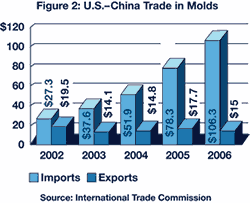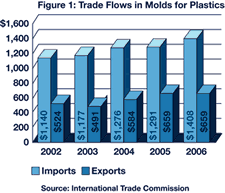Trade Policy Developments Affecting the U.S. Moldmaking Industry
Mold manufacturers must become aware of the trade policy developments affecting their industry and reach out to their elected officials, sharing with them their trade-related interests and concerns.
Share
U.S. moldmakers operate in an increasingly global business environment, where market opportunities arise both domestically and internationally, and competitors are not only fellow U.S. companies but also foreign manufacturers. Today, trade developments affect most moldmakers, and companies have a vested interest in monitoring trade policy and communicating their trade interests and concerns to policymakers.
Trade Flows in Molds for Plastics
As a starting point of the discussion of the impact of trade developments, it is useful to review recent trade flow trends. Because molds for plastics account for about three-quarters of U.S. trade in molds, the following data focus on trade in plastics molds. As Figure 1 shows, U.S. exports of plastics molds remained virtually unchanged in 2006 at nearly $659 million, after double-digit rates of expansion in 2004-2005.1 The value of imports, on the other hand, continued to increase and reached $1.4 billion last year. As a result, the U.S. trade deficit in molds expanded to $749 million, reversing a temporary decline in 2005. Statistics from the past several years demonstrate that trade flows in molds for plastics are fairly volatile and are affected by many factors in the international marketplace—including prices for energy and steel, foreign competition, and developments in the global plastics industry.
Mexico and Canada are the primary destinations of U.S. mold exports. Exports to Mexico, in particular, have grown substantially in recent years, rising by two-thirds from 2004 to 2006 to $336.9 million. The U.S. moldmaking industry also has its largest trade surplus with Mexico, at $306.5 million in 2006. China, Hong Kong and Germany also are important export partners for U.S. moldmakers.
Canada dominates U.S. mold import flows and holds a nearly 20 percent share of the U.S. molds market. Canada accounts for more than half of all plastics mold imports into the United States, as well as for the largest trade deficit in molds ($497.6 million). Other major import sources include Japan, China, Germany and Taiwan. Last year, China overtook Germany to become the third-largest seller of imported molds into the U.S. market. Mold imports from China increased by over 35 percent last year, and have doubled since 2004 (see Figure 2).
When exploring the current trends in trade flows in molds, it is useful to look at the export intensity and import penetration of the moldmaking industry. In 2005, exports of molds accounted for 21.7 percent of domestic shipments, a 5.8 percent increase over 2003. At the same time, imports held a 35.1 percent share of the U.S. market, gaining 3.9 percent since 2003. Surging mold imports from China are a key factor in the recent rise in the U.S. trade deficit in molds and the growing import penetration of the U.S. mold market. The export data also demonstrate that the U.S. moldmakers are increasingly looking abroad for new market opportunities, as demand for molds continues to grow in emerging plastics markets.
U.S. Trade Policy Developments
In 2007, U.S. trade policy at both the Administration and Congressional levels has two primary dimensions: (1) trade liberalization, through bilateral and multilateral trade agreements and the associated extension of the President’s trade promotion authority; and, (2) more aggressive enforcement of U.S. trading rights and foreign partners’ trade obligations, with a particular focus on China.
On the trade liberalization front, the Bush Administration continues to pursue an active agenda of negotiating and implementing bilateral free trade agreements (FTAs) and pursuing an ambitious agreement in the Doha Round of multilateral trade negotiations under the auspices of the World Trade Organization (WTO).
The Administration has completed FTAs with Peru, Colombia and Panama, which are currently awaiting Congressional ratification. At press time, intense FTA negotiations also were underway with South Korea and Malaysia, with the goal of their completion by the end of March. This deadline is necessitated by the pending expiration of the President’s Trade Promotion Authority (TPA, also known as “fast track”) on June 30, 2007.
TPA is an essential tool for the executive branch, allowing it to negotiate trade agreements that Congress may approve or reject in their entirety, but cannot amend. In granting TPA to the executive branch, Congress establishes certain parameters for the contents and types of trade agreements to be negotiated by the Administration, as well as a consultative process for Congressional input into trade talks. As TPA is set to expire in mid-year, renewal of this authority will likely be the overarching trade legislative priority for the Bush Administration this year.
The prospects for extension or renewal of TPA are unclear at this time, however. Congressional Democrats are concerned with the Administration’s handling of labor and environmental issues in recently-negotiated trade agreements. Additionally, many in Congress are dissatisfied with the level of consultations between Administration officials and members of Congress during trade negotiations. Key members of Congress have indicated that they may be amenable to a short-term (i.e. six-month) extension of TPA this year to allow for the successful completion of the Doha Round and postpone a more thorough debate on TPA until after the 2008 election cycle.
The Doha Round of multilateral trade talks is a comprehensive negotiations process involving all members of the WTO and most aspects of international trade. Launched in 2001, the Round is aimed at significant reductions in tariffs and non-tariff trade barriers in agricultural products, manufactured goods and services. Certain developing countries, including Brazil and India, maintain high tariffs on mold imports, and the prospective reduction in these tariffs would create new export opportunities for U.S. moldmakers. The Doha Round negotiations are at an advanced stage, but wide differences remain among key participating countries. U.S. officials are seeking an ambitious outcome of the Doha Round, with real improvements in market access abroad for U.S. exporters.
In the current political environment in Washington, there is greater skepticism on trade issues among many lawmakers, and increased focus in Congress on trade enforcement. Many legislators are particularly concerned about the persistent deficiencies in China’s implementation of the obligations that it undertook when it joined the WTO in late 2001. Most importantly, China continues to subsidize a wide array of industries, maintain an undervalued currency and turn a blind eye to intellectual property rights (IPR) infringement.
Reflecting the increased focus on China this year, several legislative proposals to address the impact of China’s industrial subsidies and currency manipulation have emerged. Notable among these are bills that would direct the Commerce Department to apply U.S. anti-subsidies statutes (known as “countervailing duty” laws) to subsidized imports from non-market economies such as China and would designate “currency misalignment” as an export subsidy under U.S. law. There is growing support for these bills in the current Congress and it is increasingly likely that lawmakers will take action on these issues this year.
The Administration also is under pressure by both industry and Congress to utilize all tools at its disposal to compel the Chinese government to comply with its international trade obligations. In an apparent sign that Administration officials are heeding this concern, the U.S. government recently filed a case with the WTO against several Chinese subsidy programs. These subsidies specifically encourage the beneficiary companies to export their production or to purchase domestic equipment and inputs rather than imports. Known as “export-” and “import-substitution” subsidies, such programs are explicitly prohibited under WTO rules because they distort trade flows. The Administration also may bring a WTO dispute against China’s IPR enforcement in the coming months, and is already engaged in a case against China’s tariffs on imported automotive parts.
Lastly, the U.S. government maintains a policy of diplomatic engagement with Beijing on these and other trade issues, including the undervalued Chinese currency, IPR protection and various Chinese regulatory actions that affect U.S. exporters. Diplomatic activity occurs on a number of levels and through several fora. Notable among these are the annual Cabinet-level meetings of the U.S.-China Joint Commission on Commerce and Trade (JCCT) led by the Commerce Department and a new “Strategic Economic Dialogue,” which Treasury Secretary Henry Paulson launched in December 2006.
Implications for the U.S. Moldmaking Industry
Despite substantial cost pressures and domestic market challenges, U.S. mold manufacturers have been able to maintain strong industry performance in recent years (see Recent Industry Trends sidebar). The U.S. moldmaking industry is becoming even more international, as both the share of exports in domestic shipments and import penetration are rising. In this environment, moldmakers are increasingly affected by trade policy developments and by government efforts to open foreign markets and enforce U.S. trade rights abroad.
As the United States enters into a growing number of FTAs, trade liberalization is leading to new export opportunities for mold manufacturers. Trade flows with FTA partners are expanding, and demand for U.S. molds is strong in most FTA markets. Overall, U.S. manufacturing exports to FTA partners are rising twice as fast as to non-FTA trade partners, and mold sales are no exception. As the large mold trade surplus with Mexico underscores, mold manufacturers have benefited from the North American Free Trade Agreement (NAFTA), and are now also benefiting from rising exports to other FTA partners.
Fueled by demand for plastics products and growth in plastics manufacturing, significant opportunities also exist for U.S. moldmakers to expand their market share in emerging plastics markets. Considerable export prospects exist in the countries of Eastern Europe, Russia, the Caribbean and Latin America, and Southeast Asia.
These foreign market opportunities are tempered to some extent by a number of trade challenges affecting the U.S. moldmaking industry. Intellectual property rights violations abroad, industrial subsidization, currency manipulation and foreign regulatory actions are some of the most pressing trade obstacles for mold manufacturers. The U.S. government’s trade policy can help expand exports and minimize disruption in the U.S. market not only by reducing tariffs abroad, but also by pressing trade partners to address these trade-related problems.
To ensure that the trade interests and concerns of mold manufacturers are addressed by policymakers, it is of paramount importance that the industry maintain continuous engagement with the U.S. government. Whether through industry organizations and associations, or individually, mold manufacturers should consider reaching out to their elected officials and sharing with them their trade-related interests and concerns. Active engagement with policymakers allows mold manufacturers input into policy developments and helps them improve their business environment for the future.
References
1The source of international trade statistics is the U.S. International Trade Commission.
Related Content
Predictive Manufacturing Moves Mold Builder into Advanced Medical Component Manufacturing
From a hot rod hobby, medical molds and shop performance to technology extremes, key relationships and a growth strategy, it’s obvious details matter at Eden Tool.
Read MoreHow to Improve Your Current Efficiency Rate
An alternative approach to taking on more EDM-intensive work when technology and personnel investment is not an option.
Read MoreThe Role of Social Media in Manufacturing
Charles Daniels CFO of Wepco Plastics shares insights on the role of social media in manufacturing, how to improve the “business” side of a small mold shop and continually developing culture.
Read MoreTop 10 Topics to Cover During an ISO 9001 Manufacturing Audit
Take a look at this practical hands-on approach to conducting a quality audit.
Read More




.jpg;maxWidth=300;quality=90)










.jpg;maxWidth=970;quality=90)